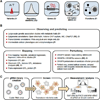Gaining insight into metabolic diseases from human genetic discoveries
- PMID: 34315631
- PMCID: PMC8578350
- DOI: 10.1016/j.tig.2021.07.005
Gaining insight into metabolic diseases from human genetic discoveries
Abstract
Human large-scale genetic association studies have identified sequence variations at thousands of genetic risk loci that are more common in patients with diverse metabolic disease compared with healthy controls. While these genetic associations have been replicated in multiple large cohorts and sometimes can explain up to 50% of heritability, the molecular and cellular mechanisms affected by common genetic variation associated with metabolic disease remains mostly unknown. A variety of new genome-wide data types, in conjunction with novel biostatistical and computational analytical methodologies and foundational experimental technologies, are paving the way for a principled approach to systematic variant-to-function (V2F) studies for metabolic diseases, turning associated regions into causal variants, cell types and states of action, effector genes, and cellular and physiological mechanisms. Identification of new target genes and cellular programs for metabolic risk loci will improve mechanistic understanding of disease biology and identification of novel therapeutic strategies.
Keywords: GWAS; common variants; epigenetics; functional annotation; genetic variants.
Copyright © 2021 Elsevier Ltd. All rights reserved.
Conflict of interest statement
Declaration of interests No interests are declared.
Figures


References
Publication types
MeSH terms
Grants and funding
LinkOut - more resources
Full Text Sources
Medical

